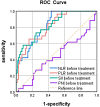Novel peripheral blood parameters as predictors of neoadjuvant chemotherapy response in breast cancer
- PMID: 36406359
- PMCID: PMC9674230
- DOI: 10.3389/fsurg.2022.1004687
Novel peripheral blood parameters as predictors of neoadjuvant chemotherapy response in breast cancer
Abstract
The neutrophil-to-lymphocyte ratio (NLR), platelet-to-lymphocyte ratio (PLR), systemic immune severity index (SII), and prognostic nutritional index (PNI) are associated with the prognosis of gastric, lung, and breast cancers. However, the predictive value of pathological complete response (pCR) rates in patients with breast cancer treated with neoadjuvant chemotherapy (NAC) remains unclear. This retrospective study explored the correlation between each index and the efficacy of neoadjuvant chemotherapy in patients with breast cancer and assessed the relationship between changes before and after neoadjuvant chemotherapy. We enrolled 95 patients with locally advanced breast cancer who received neoadjuvant therapy for breast cancer at the Second Affiliated Hospital of Fujian Medical University from April 2020 to April 2022. Based on postoperative pathology, patients were divided into pCR and non-pCR groups. Between-group differences and efficacy prediction ability of NLR, PLR, SII, and PNI were analyzed. Patient characteristics and changes in NLR, PLR, SII, and PNI before and after neoadjuvant chemotherapy (NAC) were compared between groups. Patients were divided into two groups according to the optimal diagnostic thresholds of the SII before treatment. Between-group differences in terms of neoadjuvant therapy efficacy and patient characteristics were evaluated. The pCR exhibited significantly lower ER (χ 2 = 10.227, P = 0.001), PR (χ 2 = 3.568, P = 0.049), pretreatment NLR (χ 2 = 24.930, P < 0.001), pretreatment PLR (χ 2 = 22.208, P < 0.001), pretreatment SII (χ 2 = 26.329, P < 0.001), and post-treatment PNI (P = 0.032), but higher HER-2 (χ 2 = 7.282, P = 0.007) and ΔNLR (P = 0.015) than the non-pCR group. ROC curve analysis revealed that the areas under the curve (AUC) of pretreatment SII, NLR, and PLR for predicting pCR of NAC for breast cancer were 0.827, 0.827, and 0.810, respectively, indicating a higher predictive value for response to NAC in patients with breast cancer. According to the Youden index, the optimal cut-off value of SII pretreatment was 403.20. Significant differences in age (χ 2 = 6.539, P = 0.01), ER (χ 2 = 4.783, P = 0.029), and HER-2 (χ 2 = 4.712, P = 0.030) were observed between high and low-SII groups. In conclusion, pretreatment NLR, PLR, and SII can be used as predictors of pCR in patients with breast cancer receiving neoadjuvant chemotherapy. The predictive value of pretreatment SII is higher, and patients with low SII are more likely to achieve pCR.
Keywords: breast cancer; neoadjuvant chemotherapy; neutrophil-to-lymphocyte ratio; platelet-to-lymphocyte ratio; systemic immune severity index.
© 2022 Yang, Liu, Zheng and Zeng.
Conflict of interest statement
The authors declare that the research was conducted in the absence of any commercial or financial relationships that could be construed as a potential conflict of interest.
Figures
References
-
- Chen NN, Dai D. Progress in the role of chronic inflammation in malignant tumors. Medical Innovation of China. (2020) 17(14):169–72. 10.3969/j.issn.1674-4985.2020.14.043 - DOI
LinkOut - more resources
Full Text Sources
Research Materials
Miscellaneous


